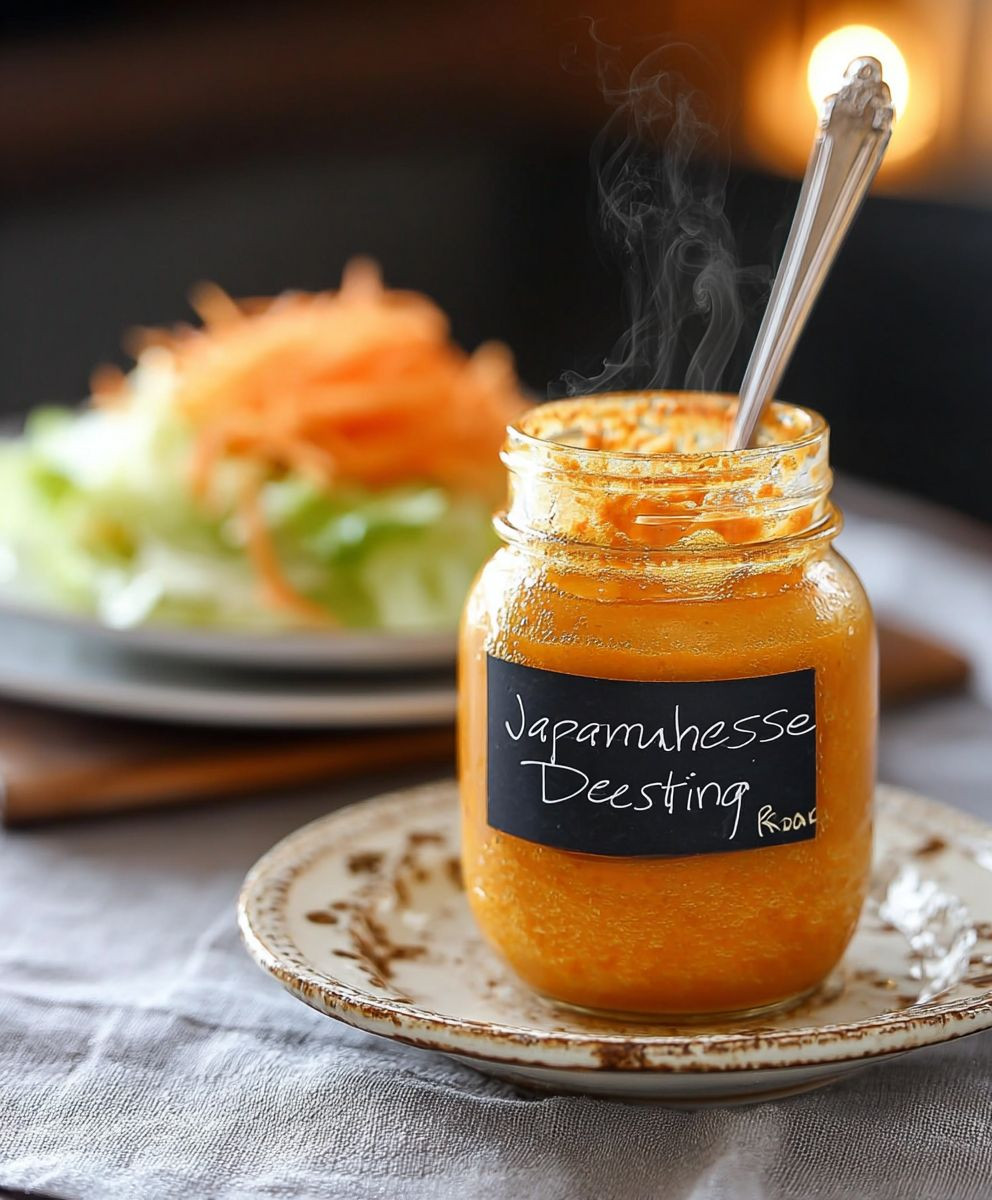Japanese Carrot Ginger Dressing: Prepare to elevate your salads to a whole new dimension of flavor! Have you ever tasted a salad dressing so vibrant, so zesty, and so utterly addictive that you wanted to drink it straight from the bottle? That’s precisely the experience you’re about to unlock with this incredible recipe.
This dressing isn’t just a condiment; it’s a culinary journey. While its exact origins are debated, carrot ginger dressing has become a staple in Japanese-inspired cuisine worldwide, often gracing the crisp greens of restaurant salads and bento boxes. Its popularity stems from its unique balance of sweet, savory, and tangy notes, a symphony of flavors that dance on your palate. The sweetness of the carrots beautifully complements the warmth of the ginger, while a touch of soy sauce and rice vinegar adds depth and complexity.
What makes this Japanese Carrot Ginger Dressing so irresistible? It’s the perfect marriage of taste and texture. The dressing is smooth and creamy, coating every leaf of lettuce with its vibrant orange hue. But beyond its visual appeal, it’s the flavor that truly captivates. People adore this dressing because it’s incredibly versatile. It’s not just for salads; drizzle it over grilled chicken or fish, use it as a dipping sauce for vegetables, or even stir it into noodles for an instant flavor boost. Plus, it’s surprisingly easy to make at home, allowing you to enjoy restaurant-quality flavor without ever leaving your kitchen. Get ready to experience a flavor explosion that will transform your salads forever!
Ingredients:
- 1 pound carrots, peeled and roughly chopped
- 1/2 cup vegetable oil (or canola oil)
- 1/4 cup rice vinegar
- 1/4 cup soy sauce (low sodium preferred)
- 2 tablespoons grated fresh ginger
- 2 tablespoons minced yellow onion
- 1 tablespoon sesame oil
- 1 tablespoon honey (or maple syrup for vegan option)
- 1 teaspoon Dijon mustard
- 1/2 teaspoon garlic, minced
- 1/4 teaspoon salt (or to taste)
- 1/4 teaspoon black pepper (or to taste)
- 2 tablespoons water (more if needed to adjust consistency)
Preparing the Ingredients:
- Prepare the Carrots: First, you’ll want to peel your carrots. I find it easiest to use a vegetable peeler for this. Once peeled, roughly chop the carrots into smaller pieces. This will help them blend more smoothly later on. Don’t worry about making them perfectly uniform; just ensure they’re small enough for your blender or food processor to handle.
- Grate the Ginger: Fresh ginger is key to that vibrant, zesty flavor. Peel the ginger root and then use a fine grater or microplane to grate it. You want about 2 tablespoons of grated ginger. The finer you grate it, the more intense the flavor will be.
- Mince the Onion and Garlic: Mince the yellow onion and garlic as finely as possible. This will ensure they blend seamlessly into the dressing and distribute their flavors evenly. I usually use a sharp knife for this, but you can also use a garlic press for the garlic.
- Measure Out the Liquids: Before you start blending, measure out all the liquid ingredients: vegetable oil, rice vinegar, soy sauce, sesame oil, and honey (or maple syrup). Having these ready to go will make the blending process much smoother.
Blending the Dressing:
- Combine Ingredients in Blender: Now, it’s time to bring everything together. Place the chopped carrots, grated ginger, minced onion, minced garlic, vegetable oil, rice vinegar, soy sauce, sesame oil, honey (or maple syrup), Dijon mustard, salt, pepper, and water into your blender or food processor.
- Blend Until Smooth: Start blending on low speed and gradually increase to high. Blend until the mixture is completely smooth and creamy. This may take a few minutes, depending on the power of your blender. If the mixture seems too thick, add a tablespoon of water at a time until you reach your desired consistency. I like my dressing to be pourable but still have a bit of body.
- Taste and Adjust Seasoning: Once the dressing is blended, give it a taste. This is your chance to adjust the seasoning to your liking. If it needs more salt, add a pinch at a time. If you prefer a sweeter dressing, add a little more honey or maple syrup. If you want more tang, add a splash of rice vinegar. Don’t be afraid to experiment until you achieve the perfect balance of flavors.
- Fine Strain (Optional): For an extra smooth dressing, you can strain it through a fine-mesh sieve. This will remove any small bits of carrot or ginger that may have escaped the blending process. However, this step is entirely optional; I often skip it because I don’t mind a little texture.
Storing and Serving:
- Transfer to an Airtight Container: Once you’re happy with the flavor and consistency of your dressing, transfer it to an airtight container. A glass jar with a lid works perfectly.
- Refrigerate: Store the dressing in the refrigerator. It will keep for up to a week. The flavors will actually meld and deepen over time, so it’s often even better the next day.
- Shake Well Before Serving: Before serving, give the dressing a good shake. This will re-emulsify the ingredients and ensure that the flavors are evenly distributed.
- Serving Suggestions: This Japanese Carrot Ginger Dressing is incredibly versatile. It’s delicious on salads, especially those with mixed greens, shredded cabbage, or Asian-inspired ingredients like edamame and seaweed. You can also use it as a marinade for grilled chicken or fish, or as a dipping sauce for spring rolls or dumplings. I even like to drizzle it over roasted vegetables like broccoli or sweet potatoes.
Tips and Variations:
- Adjust the Sweetness: The amount of honey (or maple syrup) can be adjusted to your preference. If you like a sweeter dressing, add more. If you prefer a tangier dressing, reduce the amount.
- Spice it Up: For a little kick, add a pinch of red pepper flakes to the blender.
- Make it Vegan: To make this dressing vegan, simply use maple syrup instead of honey.
- Use Different Oils: While vegetable oil or canola oil are good neutral options, you can experiment with other oils like avocado oil or grapeseed oil. Just be mindful of the flavor profile of the oil you choose.
- Add Sesame Seeds: For a nutty flavor and added texture, sprinkle a few sesame seeds on top of your salad after dressing it.
- Make a Larger Batch: This recipe can easily be doubled or tripled to make a larger batch. Just be sure to adjust the blending time accordingly.
- Freezing: While I prefer to make this dressing fresh, you can freeze it for longer storage. Pour the dressing into ice cube trays and freeze until solid. Then, transfer the frozen cubes to a freezer bag. When you’re ready to use the dressing, simply thaw a few cubes at room temperature or in the refrigerator. Keep in mind that the texture may change slightly after freezing and thawing.
- Experiment with Herbs: While this recipe focuses on ginger, you can add other herbs like cilantro or parsley for a different flavor profile. Just add a small amount at a time and taste as you go.
- Use Different Vinegars: While rice vinegar is traditional, you can also use apple cider vinegar or white wine vinegar. Just be aware that these vinegars will have a slightly different flavor.
Troubleshooting:
- Dressing is Too Thick: If your dressing is too thick, add a tablespoon of water at a time until you reach your desired consistency.
- Dressing is Too Thin: If your dressing is too thin, you can add a little more carrot or a tablespoon of tahini to thicken it up.
- Dressing is Too Bitter: If your dressing is too bitter, add a little more honey or maple syrup to balance the flavors.
- Dressing is Not Emulsifying: If your dressing is not emulsifying properly, try adding a teaspoon of Dijon mustard. Dijon mustard acts as an emulsifier and helps to bind the ingredients together.
Nutritional Information (Approximate):
Please note that the nutritional information is an estimate and may vary depending on the specific ingredients you use.
- Serving Size: 2 tablespoons
- Calories: Approximately 100-120
- Fat: 8-10 grams
- Saturated Fat: 1-2 grams
- Cholesterol: 0 mg
- Sodium: 100-150 mg
- Carbohydrates: 5-7 grams
- Fiber: 1-2 grams
- Sugar: 3-5 grams
- Protein: 0-1 gram
Enjoy your homemade Japanese Carrot Ginger Dressing! I hope you find it as delicious and versatile as I do. It’s a great way to add a burst of flavor to your salads and other dishes.

Conclusion:
This Japanese Carrot Ginger Dressing is truly a game-changer, and I wholeheartedly believe you need to make it, like, yesterday! It’s not just another salad dressing; it’s a vibrant, flavorful experience that will elevate everything it touches. From the bright sweetness of the carrots to the zesty kick of ginger and the subtle tang of rice vinegar, every ingredient works in perfect harmony to create a dressing that’s both complex and incredibly satisfying.
Why is it a must-try? Because it’s ridiculously easy to make, uses ingredients you likely already have on hand, and tastes infinitely better than anything you can buy in a bottle. Plus, it’s incredibly versatile! Forget boring salads; this dressing will transform your greens into something you actually crave.
But the possibilities don’t stop there! Think beyond salads. This dressing is fantastic drizzled over grilled chicken or fish, adding a burst of flavor to your favorite protein. It’s also amazing as a dipping sauce for spring rolls or dumplings. I’ve even used it as a marinade for tofu before stir-frying, and the results were phenomenal.
Serving Suggestions and Variations:
* Classic Salad: Toss it with mixed greens, shredded carrots, cucumbers, and a sprinkle of sesame seeds for a simple yet delicious salad.
* Asian Slaw: Combine shredded cabbage, carrots, and edamame, then dress it with this dressing for a vibrant and flavorful slaw.
* Noodle Salad: Toss cooked soba or udon noodles with the dressing, along with some chopped scallions and sesame seeds for a quick and easy meal.
* Grilled Protein Topping: Drizzle it over grilled chicken, salmon, or tofu for a burst of flavor.
* Vegetable Dip: Serve it as a dipping sauce for raw vegetables like carrots, celery, and bell peppers.
* Spicy Kick: Add a pinch of red pepper flakes or a dash of sriracha for a spicier version.
* Creamy Variation: For a creamier dressing, add a tablespoon or two of mayonnaise or Greek yogurt.
* Sweetness Adjustment: If you prefer a sweeter dressing, add a touch more honey or maple syrup.
* Nutty Flavor: Add a tablespoon of toasted sesame oil for a richer, nuttier flavor.
I’m confident that once you try this Japanese Carrot Ginger Dressing, it will become a staple in your kitchen. It’s the perfect way to add a touch of Asian-inspired flavor to any meal. It’s also a fantastic way to sneak in some extra vegetables, especially for picky eaters. The vibrant color and delicious taste are sure to win them over.
So, what are you waiting for? Gather your ingredients, fire up your blender, and get ready to experience the magic of this incredible dressing. I promise you won’t be disappointed.
And most importantly, I want to hear about your experience! Did you try it on a salad? Did you use it as a marinade? Did you add any fun variations? Share your thoughts and creations in the comments below. I can’t wait to see what you come up with! Happy cooking!
Japanese Carrot Ginger Dressing: Recipe, Uses, and Benefits
Vibrant and flavorful Japanese Carrot Ginger Dressing, perfect for salads, marinades, and dipping sauces. Easy to make at home with fresh ingredients!
Ingredients
Instructions
Recipe Notes
- Adjust Sweetness: Adjust the amount of honey (or maple syrup) to your preference.
- Spice it Up: Add a pinch of red pepper flakes for a kick.
- Make it Vegan: Use maple syrup instead of honey.
- Use Different Oils: Experiment with other oils like avocado oil or grapeseed oil.
- Add Sesame Seeds: Sprinkle sesame seeds on top of your salad after dressing it.
- Make a Larger Batch: Double or triple the recipe, adjusting blending time accordingly.
- Freezing: Freeze in ice cube trays for longer storage.
- Experiment with Herbs: Add herbs like cilantro or parsley for a different flavor profile.
- Use Different Vinegars: Use apple cider vinegar or white wine vinegar instead of rice vinegar.
- Dressing is Too Thick: Add a tablespoon of water at a time until you reach your desired consistency.
- Dressing is Too Thin: Add a little more carrot or a tablespoon of tahini to thicken it up.
- Dressing is Too Bitter: Add a little more honey or maple syrup to balance the flavors.
- Dressing is Not Emulsifying: Add a teaspoon of Dijon mustard.





Leave a Comment